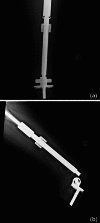From amputation to limb salvage reconstruction: evolution and role of the endoprosthesis in musculoskeletal oncology
- PMID: 24057576
- PMCID: PMC4033797
- DOI: 10.1007/s10195-013-0265-8
From amputation to limb salvage reconstruction: evolution and role of the endoprosthesis in musculoskeletal oncology
Abstract
In 1943, Austin Moore developed the first endoprosthesis fashioned from Vitallium, providing the first alternative to traditional amputation as primary treatment of bone tumors. The success of the Vitallium endoprosthesis has since then led to the development of new materials and designs further advancing limb salvage and reconstructive surgery. Combined with the advent of chemotherapy use and imaging advances, conservative treatment of musculoskeletal tumors has expanded greatly. As the implantable options increased with the development of the Lewis expandable adjustable prosthesis and the noninvasive Phenix Growing prosthesis, receiving the diagnosis of a bone tumor no longer equates to automatic limb loss. Our review details the history and development of endoprostheses throughout orthopedic oncology in the treatment of musculoskeletal tumors.
Figures





References
-
- Venable CS, Stuck WG. Results of recent studies and experiments concerning metals used in the internal fixation of fractures. J Bone Joint Surg Am. 1948;30A(1):247–250. - PubMed
-
- Moore AT, Bohlman HR. Metal hip joint: a case report. J Bone Joint Surg Am. 1943;25(3):688–692.
Publication types
MeSH terms
LinkOut - more resources
Full Text Sources
Other Literature Sources
Medical
Research Materials

